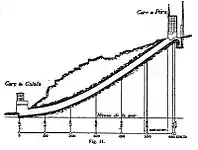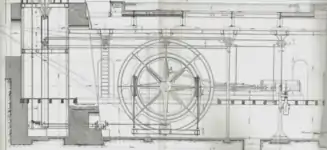Tünel
The Tünel (English: Tunnel, designated as F2 line at the Istanbul transport map[1]) is a historic subway funicular line in Istanbul, Turkey, located at the northern shore of the Golden Horn. It has two stations, connecting the quarters of Karaköy and Beyoğlu. Its tunnel goes uphill from close to sea level and is about 573 metres (1,880 feet) long.[2] Inaugurated on January 17, 1875,[2] the Tünel is the second-oldest extant subterranean urban rail line in the world, after the London Underground (1863). It is thus the oldest surviving underground urban rail line in continental Europe, as the older 1862 funicular line in Lyon has been converted into an underground road tunnel.
| Tünel | |||||||||||||||||||||||||||||||||||||||||||||||||||||||||||
|---|---|---|---|---|---|---|---|---|---|---|---|---|---|---|---|---|---|---|---|---|---|---|---|---|---|---|---|---|---|---|---|---|---|---|---|---|---|---|---|---|---|---|---|---|---|---|---|---|---|---|---|---|---|---|---|---|---|---|---|
 | |||||||||||||||||||||||||||||||||||||||||||||||||||||||||||
 Karaköy station of the Tünel | |||||||||||||||||||||||||||||||||||||||||||||||||||||||||||
| Overview | |||||||||||||||||||||||||||||||||||||||||||||||||||||||||||
| Owner | Istanbul Metropolitan Municipality | ||||||||||||||||||||||||||||||||||||||||||||||||||||||||||
| Line number | F2 | ||||||||||||||||||||||||||||||||||||||||||||||||||||||||||
| Locale | Beyoğlu, Istanbul | ||||||||||||||||||||||||||||||||||||||||||||||||||||||||||
| Termini | Karaköy (lower station) Beyoğlu (upper station) | ||||||||||||||||||||||||||||||||||||||||||||||||||||||||||
| Stations | 2 | ||||||||||||||||||||||||||||||||||||||||||||||||||||||||||
| Service | |||||||||||||||||||||||||||||||||||||||||||||||||||||||||||
| Type | Funicular | ||||||||||||||||||||||||||||||||||||||||||||||||||||||||||
| Operator(s) | İETT | ||||||||||||||||||||||||||||||||||||||||||||||||||||||||||
| History | |||||||||||||||||||||||||||||||||||||||||||||||||||||||||||
| Opened | January 17, 1875 | ||||||||||||||||||||||||||||||||||||||||||||||||||||||||||
| Technical | |||||||||||||||||||||||||||||||||||||||||||||||||||||||||||
| Line length | 0.573 km (0.356 mi) | ||||||||||||||||||||||||||||||||||||||||||||||||||||||||||
| Number of tracks | 1 (with a passing loop) | ||||||||||||||||||||||||||||||||||||||||||||||||||||||||||
| Character | Underground | ||||||||||||||||||||||||||||||||||||||||||||||||||||||||||
| Track gauge | 1,435 mm (4 ft 8 1⁄2 in) | ||||||||||||||||||||||||||||||||||||||||||||||||||||||||||
| Maximum incline | 15% | ||||||||||||||||||||||||||||||||||||||||||||||||||||||||||
| |||||||||||||||||||||||||||||||||||||||||||||||||||||||||||
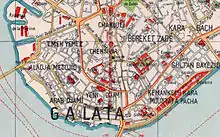
.JPG.webp)
History
In the second half of the 19th century the neighborhoods of Pera (modern day Beyoğlu) and Galata (modern day Karaköy) had become the financial and commercial heart of Constantinople (modern day Istanbul) and the Ottoman Empire. Many Ottoman and foreign companies, mostly banks and insurance companies, set up their headquarters in these two neighborhoods. Separated by a large hill, foreign embassies, hotels and commercial markets in Pera were located on the top while the stock exchange, banks and ports in Galata were at the bottom. Travelling between these two districts was challenging, since grades were as steep as 24%. The main street between these two areas, Yüksek Kaldırım Avenue, saw an average of 40,000 people commuting up and down the hill daily.[3]
In 1867 a French engineer, Eugène-Henri Gavand, came to Constantinople as a tourist.[3] During his visit, he was taken aback at the number of people travelling on Yüksek Kaldırım Avenue. Gavand thought of a method to connect these two areas, and came up with building a funicular railway that would ascend and descend the hill. Gavand went back to France shortly after to prepare his project. He returned to Constantinople in February 1868 to present his project to the Sublime Porte. The railway would run from beginning of Yüksek Kaldırım Avenue in Pera to Yenicami street and close to the Galata Bridge in Galata. On 10 June 1869 Sultan Abdülaziz granted Gavand with a concession to build the railway. Gavand worked with shareholders in France to start up a company to build the railway, but due to the Prussian invasion of France, the formation of a French-based company became impossible.
During the war, Gavand went to the United Kingdom to set up the company there. He formed the Metropolitan Railway of Constantinople to construct the line with the starting date being on 1 September 1871. Construction began on July 30, 1871 but was delayed significantly by conflicts between landowners and the company.[3] The tunnel was not completed until December 1874, [2] and was finally opened for service on January 17, 1875.[2] Gavand was notably absent at the opening ceremony.[4]
The Metropolitan Railway company gained a fresh 75-year concession in 1904. In 1911, though after some transformations, the rights to the Tünel were transferred to the new multinational consortium, Union Ottoman Société d'Intrepises Electriques à Constantinople. This consortium incorporated Tünel, the trams, and the Ottoman Joint Stock Electric Company.[5] In 1939 it was absorbed into the new IETT (İstanbul Elektrik Tramvay ve Tünel) transportation organization.[6]
In 1968 the Tünel was closed for renovation and then in 1971 it was reopened modernised and electrified.[4] Then in 2007 the Tünel passed yet another stage of renovation which particularly addressed the seismic resistance of the construction.[7]
Today, the short line is no longer as vital for Istanbul's inner city traffic as it used to be back in the 19th century, but it is still a part of the municipal transport network and integrated tickets are valid.
Description
The Tünel consists of a single brick-lined tunnel measuring 554.8 metres (1,820 ft) long, 6.7 metres (22 ft) wide and 4.9 metres (16 ft) high. It has one station at either end:
- Karaköy — the lower station, located on the eastern end of Tersane Avenue
- Beyoğlu — the upper station on Tünel Square (Tünel Meydanı), located at the southern end of Istiklal Avenue
The upper station stands 61.55 metres (201.9 ft) higher than the lower one.
The slope of the tunnel varies along its length from 2 percent to 15 percent. Originally built with two parallel tracks,[3] the modern Tünel has a single track with a passing loop in the middle, a short duplex section, where two trains pass side by side.[4]
Rolling stock
The original rolling stock on the Tünel consisted of two wooden two-car trains. One car was reserved for passengers, with two classes provided, each of which had separate compartments for men and women. The other car was used to transport goods, animals and carts. Motive power was provided by steam engines.[4]
The wooden carriages were replaced in 1971 with two electrified steel cars running on pneumatic tires over concrete tracks,[8] thus similarly to the rubber-tyred metro it could be called a rubber-tyred funicular.
In 2007 yet another generation of a rolling stock was brought into operation. The maximum speed of a car is 22 km/h (14 mph). A trip between the two stations takes about 1.5 minutes, with normal waiting time 3.5 minutes. The maximum capacity of a car is 170 passengers.[4]
Gallery
- Historical drawings
- Photos
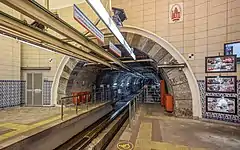 Karaköy station with the tunnel portal
Karaköy station with the tunnel portal Karaköy station in 2006 decorated in moresque style
Karaköy station in 2006 decorated in moresque style The tunnel between Beyoğlu and Karaköy station
The tunnel between Beyoğlu and Karaköy station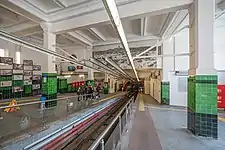 Beyoğlu station
Beyoğlu station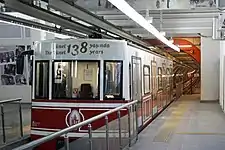 Train at Beyoğlu station
Train at Beyoğlu station
See also
References
- "Istanbul Railway Systems map". metro.istanbul.
- "Tunnel". IETT. Retrieved 2014-04-25.
- Çelik, Zeynep (1993). The remaking of Istanbul: portrait of an Ottoman city in the nineteenth century. University of California Press. pp. 96-98. ISBN 978-0-520-08239-7.
- Eren Kayaoğlu, Adem Candaş, Y.Ziya Kocabal, C.Erdem İmark (2014-03-14). "Early Application of Underground Funicular 'Tunnel' in Istanbul" (PDF). İTÜ - Transport Tekniği Grubu. Archived (PDF) from the original on 2017-12-05. Retrieved 2017-12-05.CS1 maint: uses authors parameter (link)
- "Tunel Company Changing Hands". İETT - Tunnel. Retrieved 2017-12-06.
- "Nationalization Of Tunel". İETT - Tunnel. Retrieved 2017-12-06.
- "Tünel Kronolojisi" [Tünel Chronology]. İETT - Tunnel (in Turkish). Retrieved 2017-12-07.
- "The 1971 funicular". Funimag (26). September 27, 2005. Retrieved 2009-07-19.
External links
| Wikimedia Commons has media related to Tünel. |
- İETT - Tunnel — the official portal (in English)

